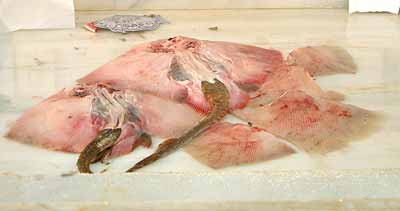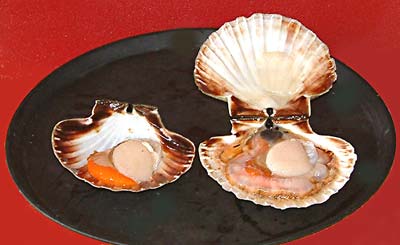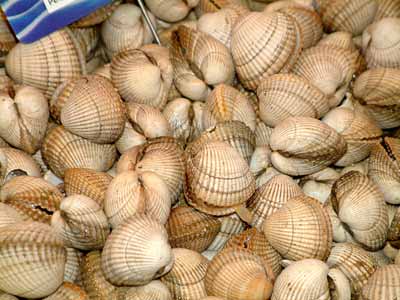Horse mushroom. Edible, and very delicious, but easily mistaken for other less palatable or even poisonous mushrooms.

Thornback ray. A variety of ray with very good flavour, the wings and the liver only being eaten. The wings have strips of cartilage running through them, rather than bone, and are easy to deal with at the table as the flesh drops away readily. As the name suggests, the backs of the fish may have clumps of coarse thorny spines, swelling at the base. These are called bucklers. Thornbacks have a range right from Iceland to the Mediterranean.
A broth made from sheep's offal (US: organ meat) served over a slice of bread. Generally it is followed by the meats that have been cooked in the broth.

Pilgrim or great scallop. These are shellfish with white meats and pink corals, often cooked in their shells with the corals and have sweet, succulent meat if properly cooked. According to legend, the body of St James (St-Jacques) travelled with a boat with neither oars nor sails around the Iberian coast, coming to rest in Compostela. Many miracles were associated with this journey, including one where the horse of a pagan nobleman leaped into the sea. They emerged carrying the body of St James covered in scallop shells. This resulted in the nobleman converting to Christianity. Pilgrims to Santiago de Compostela have traditionally worn scallop shell badges in commemoration of St James, or used scallop shells as begging bowls. The whole pilgrim route is decorated with his emblem. In some parts of Europe they are eaten on the feast day of St James on 25 July to commemorate the arrival of pilgrims or peregrinos at Santiago de Compostela, often with tomatoes and garlic. They are more often simply and lightly fried.

Cockle. Edible, bivalve shellfish found in sandy coastal waters throughout the world. They vary from tiny and dull in colour to as much as 15 cm (6 inches) across. They have an almost circular shell and are generally available pickled in brine or vinegar. However, they can be found fresh in some parts of the world in which case they can be eaten either raw or steamed for around five minutes and checked in the same way that you would mussels. Smaller clams include cherrystones, carpet shells, little necks, steamers or soft-shelled clams and Venus. Larger ones, which are often used in chowders, include hard shell clams and ocean quahogs. Cockles are less sweet than the more favoured clams which is why they are more often used in sauces, soups or in ready-made dishes.